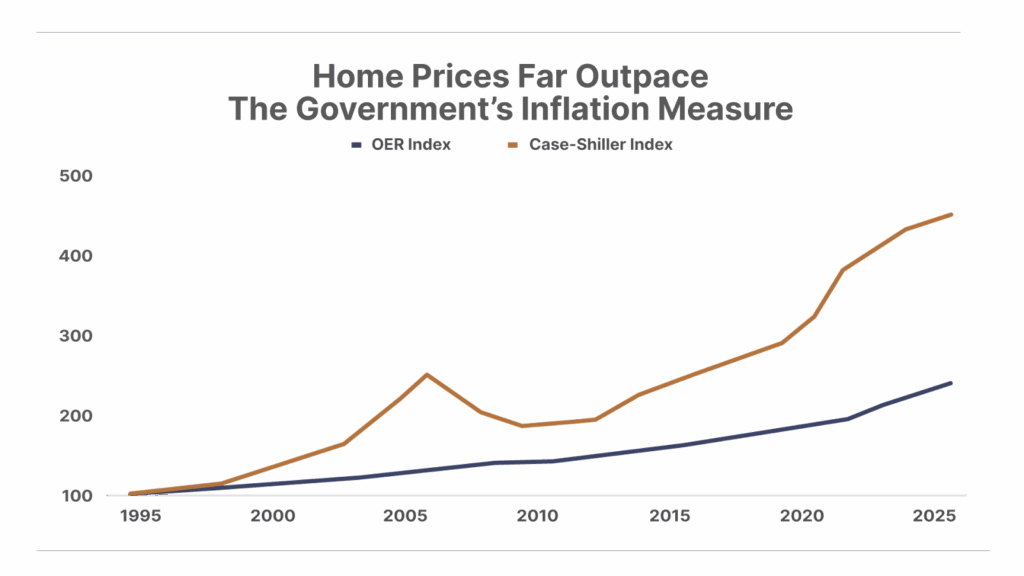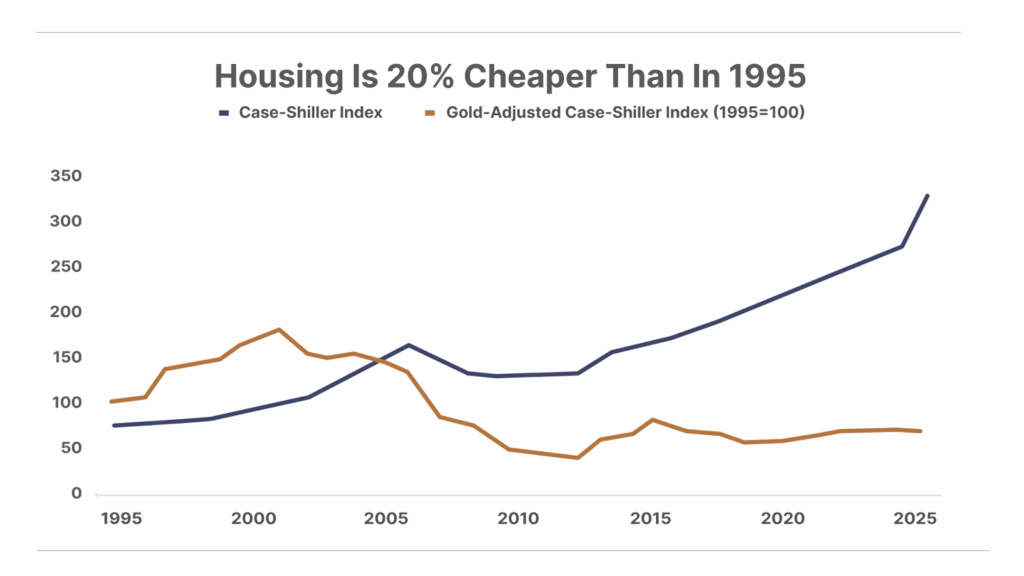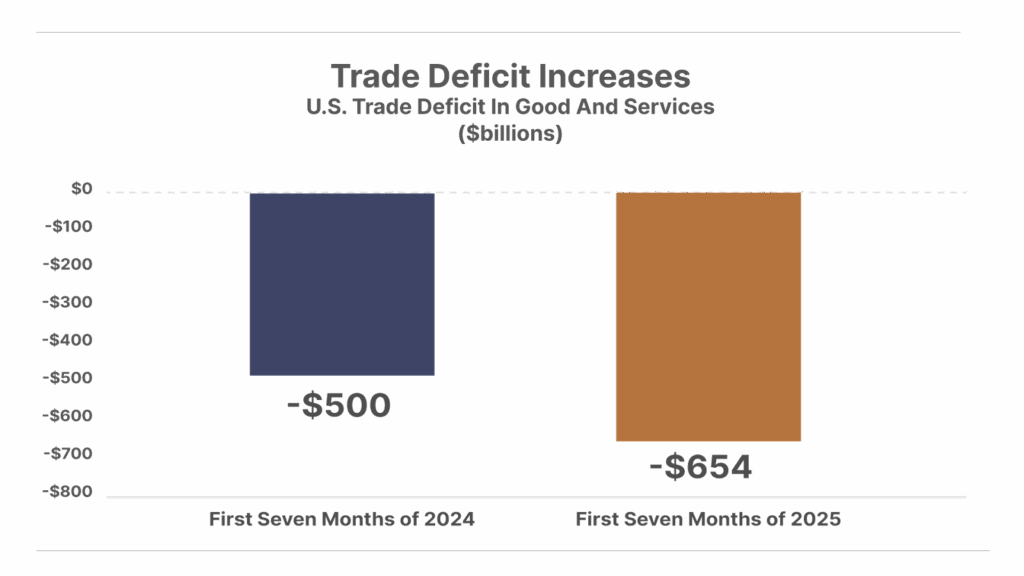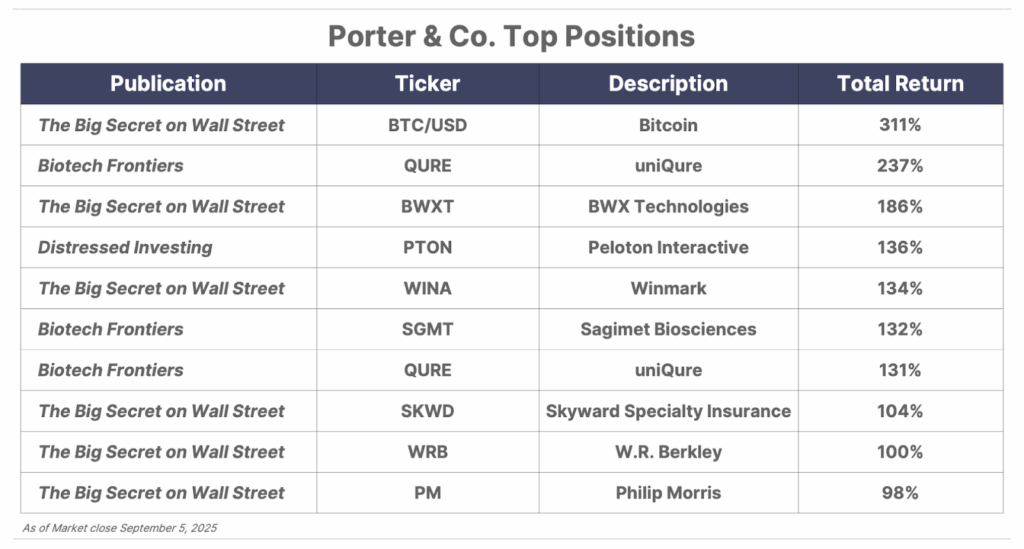Issue #103, Volume #2


Here’s How To Cash In As Rome Burns
This is Porter’s Daily Journal, a free e-letter from Porter & Co. that provides unfiltered insights on markets, the economy, and life to help readers become better investors. It includes weekday editions and two weekend editions… and is free to all subscribers.
| UFC fights at the White House… Government’s inflation measure versus real prices… Housing is cheaper, not more expensive… Debts are coming due… Prepare and you’ll get rich… The trade deficit has increased… Porter & Co’s Annual Conference… |
On Friday, I explained why the government’s consumer price index (“CPI”) figures are lies.
Today, I’m going to show you how they’re defrauding all of us.
It’s not hard to figure out. Just put yourself in their shoes. How would you defraud your creditors, if you had a printing press?
That’s right, you’d print whatever it takes to keep the charade going. You’d also do anything to control the media narrative away from these unpleasant facts… like say… hosting UFC fights on the White House lawn.
In Rome, it was bread and circuses. Today it’s welfare and UFC fights. Human nature doesn’t change.
Inflation has always been the bridge between what the politicians promise (everything) and what they can actually provide (nothing).
But there’s a problem. America’s politicians told the taxpayers that most of their taxes were “contributions.” They said these “contributions” would be invested by the Social Security Administration and used to pay out benefits to retirees.
That was all a lie, but to make it seem real, in 1975 the government promised to index these benefits to inflation. In fact, these cost-of-living-adjustments (“COLAs”) are mandated by law to happen automatically, every year.
The government owes Social Security more than $100 trillion. Even small amounts of inflation would create vastly more debt. But, as I showed you last week, we know that the actual value of the average Social Security monthly benefit has fallen by more than 50% since 1975.
So, what’s happening? Well, this will shock you, I’m sure. But it’s simple: The government lies about inflation, just like it lies about everything else.
The government’s measure of inflation, CPI-U, simply pretends that the cost of housing isn’t a real expense. Instead, 35% of the CPI measures something the government calls “owner’s equivalent rent” (“OER”). You’ll hopefully notice that there is no such good or service in our economy. It is just a bunch of nonsense.
Below, I’ve compiled every year’s increase (or decrease) to the OER since 1995. And I’ve compared it to the actual change in the price of homes, as measured by the Case-Shiller Index.
Case-Shiller is an outstanding index of actual home sales. It’s constructed using the repeat-sales methodology, which tracks the sale prices of the same single-family homes over time. Thus, Case-Shiller is the “gold standard” for measuring home prices.
So, why doesn’t the government use it?
You tell me.

Cumulatively, over the last 30 years, figures in the Case-Shiller Index are roughly 90% higher than the figures in the cumulative OER Index.
Or, in other words, the single biggest way the government is defrauding its creditors is by lying about the real cost of homes. And what’s the biggest complaint you’ll hear from most Americans these days? That housing is unaffordable.
Does it make sense now?
What does an Adler see? He sees a bankrupt government that’s defrauding its citizens by inflating away all of the gains in productivity in the entire economy. If you measure the real, economic cost of housing (not the dollar cost of housing), you’ll discover that housing is about 20% cheaper in real terms than it was in 1995, not 460% more expensive.

This is the most important economic fact of our lives: our government is bankrupt. It doesn’t merely owe bondholders $37 trillion. It also owes Social Security more than $100 trillion.
These debts are coming due in the next decade.
All of these lies and all this fraud will be exposed. Do you think the government is simply going to say, “We’re sorry.” No.
These same massive economic problems exist in all the major Western democracies. The combination of steeply progressive taxation and universal suffrage is the perfect recipe for socialism. And, for decades, we’ve relied on paper money and massive debts to create the illusion that socialism works, when powered by a capitalistic economy.
But it’s all a lie.
What happens next is what always happens when governments go bankrupt. There will be war. There will be chaos. There will be terrible strife between the competing interest groups in all these democracies, as they fight, savagely, to hold on to the advantages they have under the current, failing system.
Did you notice that Japan’s prime minister resigned over the weekend? He was in power for less than a year. Did you see how many of the German political candidates were assassinated just before their elections? Do you think U.S. President Donald Trump is rolling out the national guard in progressive cities to stop crime?
All of these problems are going to get worse. Dramatically worse.
But there’s one thing you can be sure about: The government isn’t going to pay a fair interest rate on its debt. The government is not going to tell the truth about inflation. And, eventually, a government default is 100% inevitable.
If you understand what that means, the next decade is the best opportunity you’ll ever have to acquire generational wealth.
All you must do is borrow long, at fixed rates, and buy great assets.
“Forget AI” Says Reagan’s #1 Futurist
Presented by Banyan Hill Publishing
While everyone’s chasing the same AI plays, George Gilder is focused on something completely different.
He says a 4-nanometer device that’s 80 MILLION times more powerful than the chip he gave Reagan is now being made in America for the first time.
And he’s identified 3 companies that control this technology.
Get the details before this BOMBSHELL announcement changes everything.
Three Things To Know Before We Go…
1. U.S. construction stalls. Spending on U.S. construction projects dropped 2.8% in July from a year ago, marking the 10th decline in the last 11 months. This is the longest stretch of declining construction spending in 15 years. Declines of this magnitude are typically only seen during recessions.

2. The trade deficit widened despite new tariffs. Through July, the U.S. trade deficit jumped 31% year-over-year to a record $654 billion, up from $500 billion in 2024. New tariffs raised average duties from roughly 2% to nearly 20%, with the goal of curbing imports and supporting domestic production. Instead, importers rushed to stockpile goods in the first quarter ahead of the tariff hikes. At the same time, retaliatory trade measures by U.S. partners drove exports lower, compounding the imbalance.

3. Oil prices defy OPEC+. This weekend, the OPEC+ alliance – which includes the 12 original OPEC members plus 11 allies including Russia – unexpectedly agreed to raise oil output further next month. Eight OPEC+ members said they’ll increase production by 137,000 barrels per day in October, reversing some voluntary cuts they had put in place earlier this year. Yet, despite this announcement, crude oil prices rose this morning, up roughly 1% from Friday’s close. As a big input for the CPI , this could push inflation higher.
Tell me what you think: [email protected]
Mailbag
In Friday’s Daily Journal, Porter shared how earning 50%-plus annual returns are easily achievable, on average – and without suffering the kind of drawdowns most investors believe are inevitable. In fact, this strategy has volatility that’s much lower than the market’s.
The ideas behind this investing strategy and the execution of those ideas in the markets, he calls The Solution. And, he wrote that the core ideas behind The Solution were explained to him by the legendary Austrian economist, Dr. Kurt Richebacher.
Richebacher called these ideas the secrets of the “Adler.”
Explained Porter:
“An Adler is a man set apart from the world because of the quality of his perception. He sees the world far more completely and far more accurately than others and uses that understanding to maintain his independence.”
A number of readers shared their thoughts on Friday’s essay with Porter. Here are two.
My wife and I have been with you since 2015. I have always enjoyed your writing and missed it when you stopped writing the Friday Digest. You have made such an impact on our lives, which cannot be fully expressed in an email.
Your advice on saving stands out at the moment. We had always been savers and implemented saving 50% of our income when we first read about it in your writings. You have helped us become financially independent and for that we are eternally grateful. Our returns from Porter & Co recommendations have been outstanding and we couldn’t be happier about our financial situation.
However, lately I have felt like a boat no longer under power and adrift at the whims of the current and the wind. I have been yearning for something that was missing. My real excitement came when I read about the “Adler” in your latest Daily Journal. I want to become an Adler – and not for the money. Don’t get me wrong, the extraordinary returns are very exciting, but to me, I believe in my heart, for one to become an Adler would be an exceptional achievement. Even if one fell short of becoming a true Adler, he could still be comforted in knowing he had made a noble attempt. You said “Let me help you become an Adler” and I reply, “Yes, please!”
Best regards,
David M.”
Thanks so much, Porter. Wow! “The Solution” email is definitely in the top tier of all the pearls of wisdom that you continue to share unselfishly with the primary goal of educating your audience. How I wish I had become a follower of yours long ago. I remain grateful for your wisdom, which I’ve been privileged to learn. Time is now by far the asset of scarcity, rarity, and in greatest demand to apply The Solution.
Rodger G.”
Good investing,
Porter Stansberry
Stevenson, Maryland


Please note: The investments in our “Porter & Co. Top Positions” should not be considered current recommendations. These positions are the best performers across our publications – and the securities listed may (or may not) be above the current buy-up-to price. To learn more, visit the current portfolio page of the relevant service, here. To gain access or to learn more about our current portfolios, call our Customer Care Team at 888-610-8895 or internationally at +1 443-815-4447.
